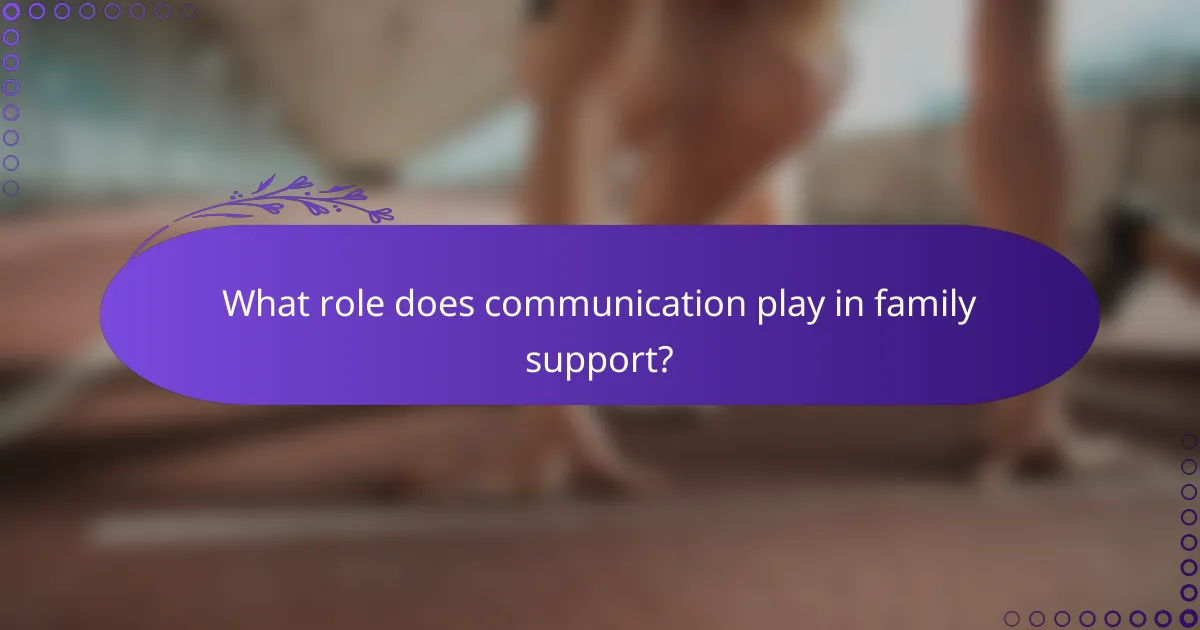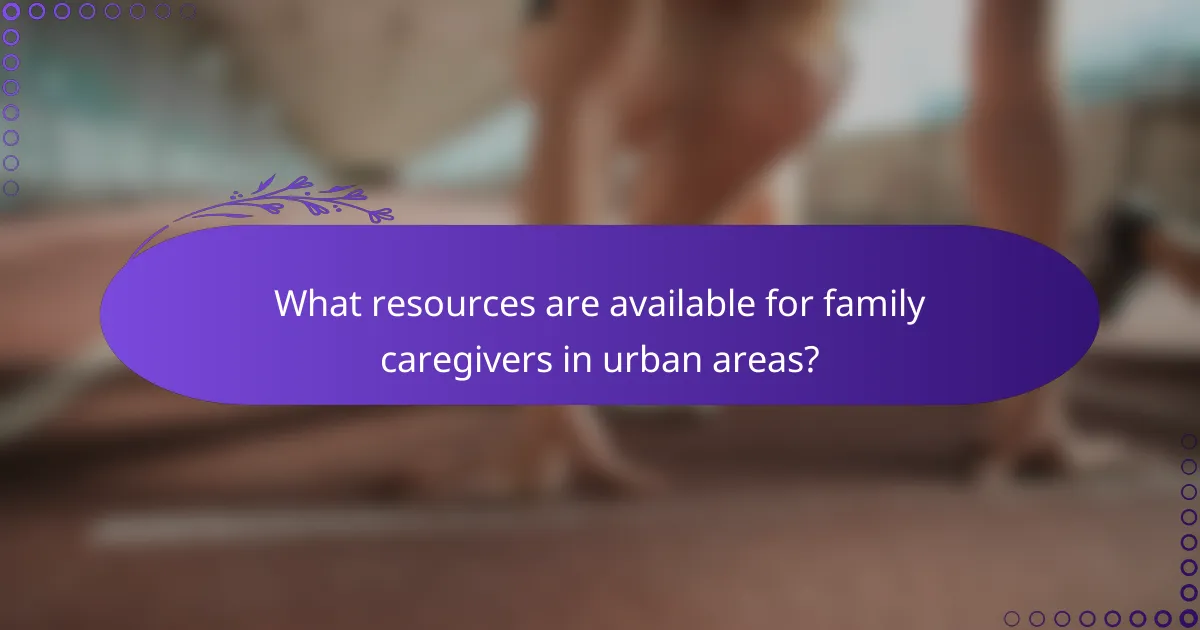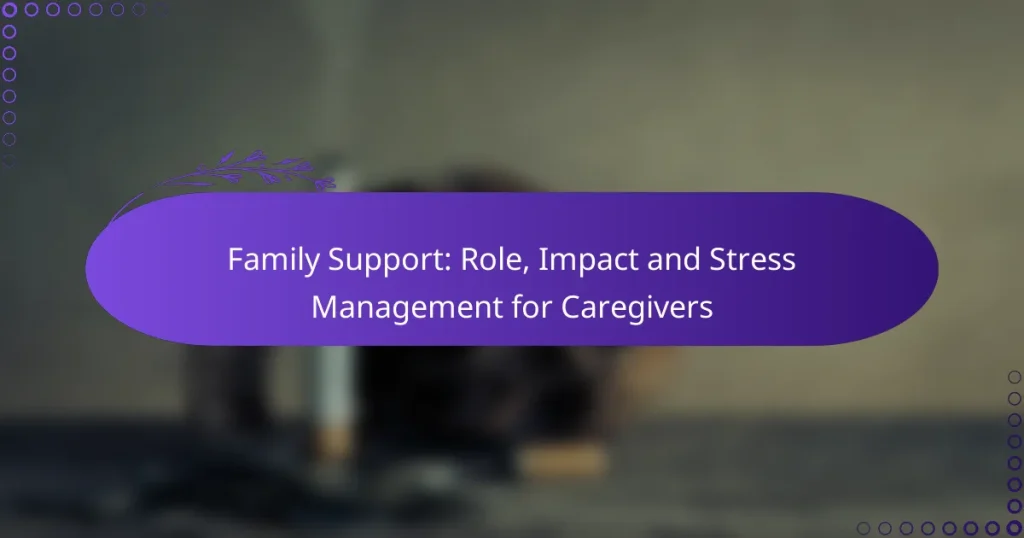Family support plays a crucial role in enhancing the well-being of caregivers by offering emotional, practical, and respite assistance. This support not only alleviates stress but also fosters resilience, enabling caregivers to prioritize their own health while caring for loved ones. Effective communication within the family is essential, as it promotes understanding and collaboration, ensuring that everyone is aligned in their caregiving roles.

How can family support improve caregiver well-being?
Family support can significantly enhance caregiver well-being by providing emotional, practical, and respite assistance. This support alleviates stress, fosters resilience, and allows caregivers to maintain their own health while caring for loved ones.
Emotional support from family
Emotional support from family members is crucial for caregivers, as it helps them cope with the challenges of caregiving. Regular check-ins, active listening, and expressing empathy can make caregivers feel valued and understood. This connection can reduce feelings of isolation and anxiety, promoting better mental health.
Family members can also encourage caregivers to share their feelings and experiences, which can lead to healthier coping mechanisms. Engaging in shared activities or simply spending quality time together can boost morale and provide much-needed relief.
Practical assistance with daily tasks
Practical assistance from family can ease the burden of daily caregiving tasks. Family members can help with chores such as cooking, cleaning, or grocery shopping, allowing caregivers to focus more on their loved ones’ needs. This division of labor can prevent burnout and improve overall family dynamics.
Establishing a rotating schedule for tasks can ensure that responsibilities are shared fairly among family members. This approach not only lightens the load but also fosters teamwork and strengthens family bonds.
Access to respite care services
Access to respite care services is vital for caregivers to recharge and maintain their well-being. Family support can facilitate this by researching and arranging for respite options, such as adult day care or temporary in-home assistance. These services provide caregivers with a break, helping to prevent exhaustion.
Caregivers should explore local resources, such as community centers or non-profit organizations, that offer respite care programs. Understanding the eligibility criteria and potential costs involved can help families make informed decisions about the best options for their situation.

What are effective stress management techniques for caregivers?
Effective stress management techniques for caregivers include mindfulness practices, physical exercise, and utilizing support groups. These methods help caregivers maintain their well-being while providing care, reducing feelings of overwhelm and enhancing emotional resilience.
Mindfulness and meditation practices
Mindfulness and meditation can significantly reduce stress for caregivers by promoting relaxation and enhancing focus. Techniques such as deep breathing, guided imagery, or simply sitting in silence for a few minutes can help clear the mind and lower anxiety levels.
Practicing mindfulness can be as simple as dedicating 5-10 minutes daily to focus on your breath or engage in a body scan meditation. Apps like Headspace or Calm offer structured programs that can guide you through these practices.
Physical exercise and wellness activities
Regular physical exercise is crucial for managing stress and improving overall health. Activities such as walking, yoga, or swimming can boost endorphins, which are natural mood lifters. Aim for at least 150 minutes of moderate aerobic activity each week, which can be broken down into manageable sessions.
Incorporating wellness activities like stretching or tai chi can also enhance flexibility and reduce tension. Even short bursts of activity, like a 10-minute walk, can provide immediate stress relief and improve mental clarity.
Support groups and community resources
Joining support groups can provide caregivers with a sense of community and shared understanding. These groups often allow caregivers to share experiences, seek advice, and find emotional support from others in similar situations.
Local community resources, such as caregiver workshops or counseling services, can also be invaluable. Many organizations offer free or low-cost programs that focus on stress management techniques, providing caregivers with tools to cope effectively.

What role does communication play in family support?
Communication is essential in family support, particularly for caregivers, as it fosters understanding and collaboration. Effective dialogue helps identify challenges, set expectations, and ensure everyone is aligned in their caregiving roles.
Open dialogue about caregiving challenges
Encouraging open dialogue about caregiving challenges allows family members to express their feelings and concerns. This transparency can lead to shared problem-solving and reduce feelings of isolation among caregivers. Regularly discussing difficulties can also help identify resources or adjustments needed to improve care.
For instance, family members can share specific instances where they feel overwhelmed, prompting discussions on how to redistribute tasks or seek external support, such as hiring a professional caregiver or utilizing community resources.
Setting boundaries and expectations
Establishing clear boundaries and expectations is crucial for maintaining healthy family dynamics. Caregivers should communicate their limits regarding time, emotional energy, and physical capabilities to prevent burnout. This clarity helps family members understand their roles and responsibilities in the caregiving process.
A practical approach is to create a written agreement outlining who will handle specific tasks, such as meal preparation or transportation, ensuring everyone knows what is expected of them. This can help alleviate stress and foster a sense of teamwork.
Regular family meetings for updates
Holding regular family meetings provides a structured opportunity to discuss updates and changes in the caregiving situation. These meetings can help keep everyone informed about the care recipient’s condition and any new challenges that arise. Consistent communication ensures that all family members are on the same page and can contribute to decision-making.
Consider scheduling these meetings weekly or bi-weekly, depending on the family’s needs. Use this time to review care plans, discuss any adjustments, and celebrate successes, reinforcing a supportive family environment.

How can caregivers identify their own needs?
Caregivers can identify their own needs by regularly reflecting on their physical, emotional, and mental well-being. This self-awareness helps them recognize when they require support or a break to maintain their health and effectiveness in their caregiving role.
Self-assessment tools for caregivers
Self-assessment tools can help caregivers evaluate their needs and stress levels. Simple questionnaires or checklists can guide them in identifying areas where they may be struggling, such as fatigue, emotional strain, or lack of support. Online resources and mobile apps specifically designed for caregivers can offer structured assessments.
For example, caregivers can use tools like the Caregiver Self-Assessment Questionnaire (CSAQ) to gauge their own well-being. Regularly completing these assessments can provide insights into changing needs over time.
Recognizing signs of burnout
Burnout can manifest in various ways, including physical exhaustion, emotional detachment, and decreased performance. Caregivers should be vigilant for symptoms such as chronic fatigue, irritability, or a sense of helplessness. Recognizing these signs early can prevent further deterioration of their health.
Common indicators of burnout include changes in sleep patterns, increased anxiety, and withdrawal from social activities. Caregivers should take note of these signs and consider them as signals to reassess their self-care strategies.
Seeking professional help when necessary
If caregivers notice persistent signs of burnout or struggle to manage their needs, seeking professional help is crucial. Mental health professionals can provide support through counseling, therapy, or support groups tailored for caregivers. This external support can offer valuable coping strategies and emotional relief.
Caregivers should not hesitate to reach out for help, as it is a sign of strength, not weakness. Many communities offer resources, including hotlines and local support groups, which can be beneficial in connecting caregivers with the help they need.

What are the impacts of caregiver stress on family dynamics?
Caregiver stress can significantly disrupt family dynamics, leading to strained relationships, emotional distress in children, and shifts in family roles. Understanding these impacts is crucial for maintaining a healthy family environment.
Effects on relationships with family members
Caregiver stress often results in increased tension and conflict among family members. As caregivers become overwhelmed, they may withdraw emotionally or lash out, leading to misunderstandings and resentment.
Open communication is essential to mitigate these effects. Families should encourage discussions about feelings and challenges, which can help rebuild trust and understanding.
Impact on children’s emotional health
Children in families with stressed caregivers may experience anxiety, depression, or behavioral issues. They often sense the caregiver’s emotional strain, which can lead to feelings of insecurity and fear.
To support children’s emotional health, caregivers should prioritize quality time with them, ensuring they feel valued and secure. Engaging in activities together can foster connection and alleviate some stress.
Changes in family roles and responsibilities
Caregiver stress can lead to a reorganization of family roles, with other members taking on additional responsibilities. This shift may create feelings of resentment or inadequacy among those who feel burdened.
It is important for families to clearly define roles and responsibilities, ensuring that no one feels overwhelmed. Regular family meetings can help address these changes and redistribute tasks fairly, promoting a more balanced family dynamic.

What resources are available for family caregivers in urban areas?
Family caregivers in urban areas can access a variety of resources designed to support their needs. These resources include local support groups, online platforms, and community services that provide assistance and information tailored to caregivers.
Support groups and community organizations
Support groups and community organizations offer a vital network for family caregivers. These groups provide emotional support, practical advice, and opportunities to connect with others facing similar challenges. Many urban areas have local chapters of national organizations that focus on specific conditions, such as Alzheimer’s or Parkinson’s disease.
Caregivers can find these groups through community centers, hospitals, or online directories. Participating in regular meetings can help alleviate feelings of isolation and provide access to valuable resources.
Online resources and forums
Online resources and forums are increasingly popular for family caregivers seeking information and support. Websites dedicated to caregiver issues often feature articles, videos, and discussion boards where caregivers can share experiences and advice. Examples include AARP’s caregiving section and the Caregiver Action Network.
These platforms allow caregivers to connect with others beyond their local area, offering diverse perspectives and solutions. Many forums also provide access to experts who can answer specific questions about caregiving challenges.
Government and nonprofit assistance programs
Government and nonprofit assistance programs can provide financial and practical support to family caregivers. Many urban areas have programs that offer respite care, training, and financial aid for caregivers. These programs may vary by location, so it is essential to check local government websites or contact social services for available options.
Additionally, some nonprofits focus on specific populations, such as veterans or low-income families, offering tailored assistance. Understanding eligibility requirements and application processes is crucial for accessing these resources effectively.


